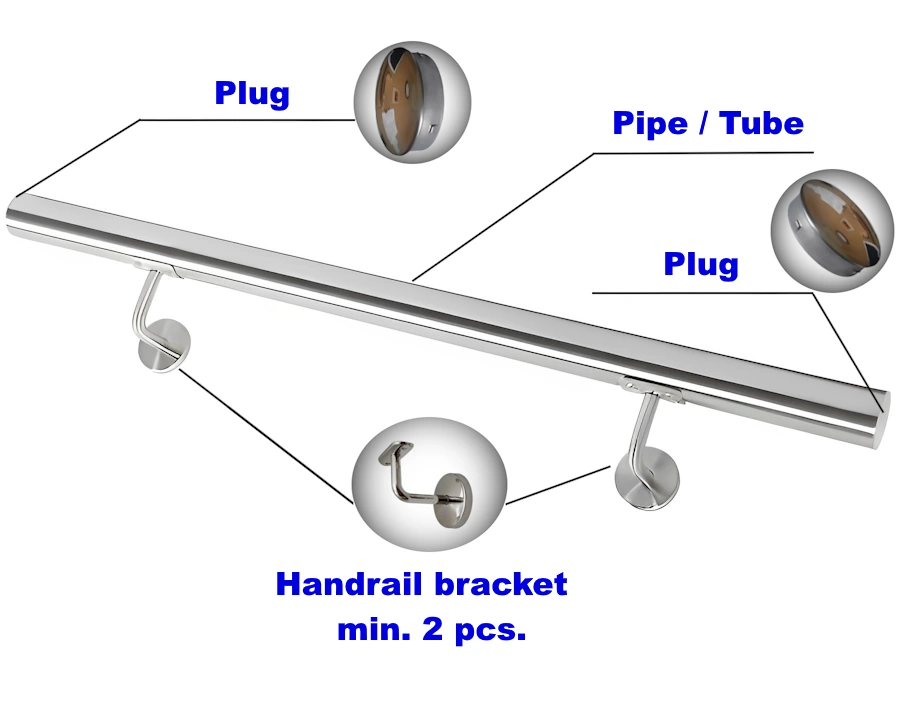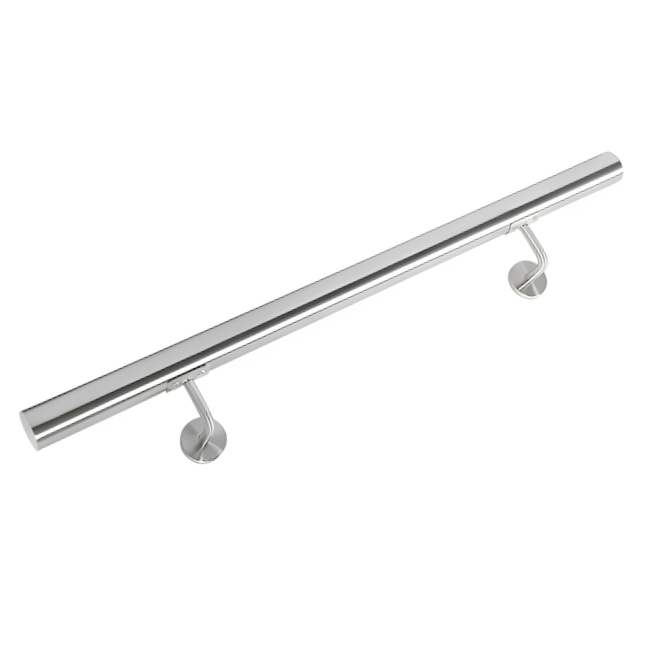Stainless steel wall handrails are a great alternative to traditional handrails and / or their stylish and practical addition. They help people to secure the ascent and descent of stairs, make it more convenient and easier. Such structures are made of stainless steel (stainless steel wall handrail) - strong, durable, reliable and, most importantly, resistant to corrosion.
Advantages of stainless steel wall handrail
The composition of stainless steel of the corresponding grade contains a certain amount of chromium, nickel, molybdenum and other alloying elements. That is why the wall-mounted stainless handrail is not subject to corrosion and oxidation. A reliable protective oxide layer is formed on the surface of the handrail, preventing rust and oxide from appearing. Such a handrail does not require additional anti-corrosion treatment, painting and is almost immediately completely ready for use immediately after installation. Main features and advantages:
- not subject to corrosion;
-does not burn;
- does not deform;
- maintains an attractive appearance for a long time;
- can be mounted both indoors and outdoors;
- resistant to high mechanical loads;
- does not require special care;
- scratch and impact resistant;
- combines well with other building materials.
How can you make such a wall-mounted handrail with your own hands ?
In order to independently install a stainless steel wall handrail, you need to know what components, parts, and pieces it consists of. In the figure below, you can see all the design details of such a product. Installation can be done independently with a minimum set of necessary tools and, most importantly, without welding or post-weld treatment of seams.

As you can see above, to make a handrail at home, you need to purchase / buy:
- a round stainless steel pipe for the handrail / or a profile pipe;
- stainless steel plugs;
- handrail holders (handrail bracket to the wall).
All this can be purchased in Ukirs at an affordable price.
Selecting components for handrails
The purchase and selection of the necessary components for your future handrail should be approached most responsibly because the appearance, reliability, durability and ease of use of your handrail will depend on the correct choice. So, "Where to start?" - you ask...
⓵ Stainless steel grade of handrail
The choice of the grade of stainless steel material is very important. You need to clearly understand once and for all that not all stainless steel is the same and that each grade of stainless steel is specially created for certain conditions / a certain environment of use in which the metal will truly remain stainless and will not lose its basic properties for a very long time. Use our reference to understand how huge the choice of stainless steel grades and corrosion-resistant alloys exists in the world.
However, Kyiv, like the whole of Ukraine, most often uses stainless steel grades AISI 201, AISI 304 and, less often, AISI 316 for handrails. If your future handrail will be located in a dry room, use AISI 201 (it is relatively inexpensive). In a room where a high concentration of moisture in the air is possible (bath, sauna, shower, basement, cellar, etc.), use at least AISI 304. Outside the room, AISI 304 should be used. In rooms with an aggressive environment or outdoors, where the air is heavily polluted or in the marine / coastal zone, use AISI 316 stainless steel or its analogues. The price of the handrail will also depend on the choice of grade.
So, if you already know where your future wall-mounted stainless steel handrail will be located, then choosing the grade of stainless steel for it will be quite simple.
⓶ Outside diameter of the handrail
You can choose the outer diameter based on your own needs or the needs of the person who will use the handrail. The following outer diameters are most often used: 32, 33.7, 38, 40, 42.4, 48.3, 50.8, 52, 54 mm. So, a handrail with a diameter of 32 mm (cheap handrail), although it will not look as prestigious compared to handrails of a larger diameter, is still a standard size. This diameter is often used as a standard for making handrails for people with disabilities: "handrail for the disabled", "stainless steel handrail for the disabled". The thirty-second diameter is quite comfortable to hold in your hand. Handrails with a diameter of 38, 40, 42.4 mm - belong to the middle price group. Diameters 48.3, 50.8, 52, 54 - to the elite group with the highest price.
It should be noted that the standard wall thickness of a stainless steel pipe for handrails is 1.5 mm and all standard accessories for handrails (plugs for stainless steel pipes of the corresponding diameter, holders / brackets) are suitable for this thickness.
⓷ Handrail length
The maximum length of the handrail is limited by the standard length of the stainless steel pipe: 6 (six) meters. And this is another advantage of a handrail assembled by yourself, since you can make your handrail of almost any length, but not exceeding 6 meters.
However, remember: stainless steel pipe for wall-mounted handrails is sold in multiples of 3 (three) meters. And, accordingly, if you want a handrail length of 2.5 meters, you need to buy a pipe 3 meters long, if the handrail length is 4 meters, you will need to buy a pipe 6 meters long, etc.
In combination with stainless steel, wood, plastic, copper, brass or other materials can be used for handrails. Stainless steel wall railings can be removable or stationary. If you want to weld the fasteners to the pipe for greater reliability and strength, you must have experience in welding stainless steel, or use the services of an experienced welder. However, in this case, the cost of the structure will increase.
Welded wall handrails are usually installed in public places where they will be subject to maximum load: metro, descents/ascents of underground passages, clinics, hospitals, other medical institutions, educational and training institutions - kindergartens, schools, boarding schools. Also railway stations, airports, municipal institutions, etc.
In any case, the wall handrail must be installed correctly and securely, because the safety of people depends on the quality of the fasteners.
